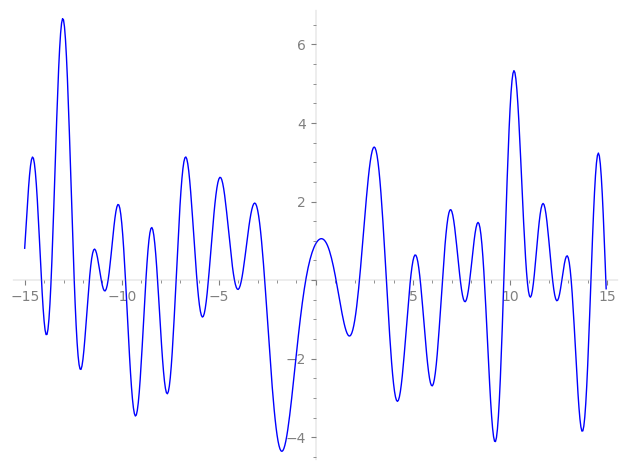| L(s) = 1 | + (−0.866 + 1.5i)3-s + (−1.86 + 1.23i)5-s + (0.866 − 0.5i)7-s + (−1.5 − 2.59i)9-s + (−2 − 3.46i)11-s + (2.59 + 1.5i)13-s + (−0.232 − 3.86i)15-s + i·17-s + 1.73i·21-s + (−1.73 − i)23-s + (1.96 − 4.59i)25-s + 5.19·27-s + (−4.5 − 7.79i)29-s + (1 − 1.73i)31-s + 6.92·33-s + ⋯ |
| L(s) = 1 | + (−0.499 + 0.866i)3-s + (−0.834 + 0.550i)5-s + (0.327 − 0.188i)7-s + (−0.5 − 0.866i)9-s + (−0.603 − 1.04i)11-s + (0.720 + 0.416i)13-s + (−0.0599 − 0.998i)15-s + 0.242i·17-s + 0.377i·21-s + (−0.361 − 0.208i)23-s + (0.392 − 0.919i)25-s + 1.00·27-s + (−0.835 − 1.44i)29-s + (0.179 − 0.311i)31-s + 1.20·33-s + ⋯ |
Λ(s)=(=(1260s/2ΓC(s)L(s)(0.958+0.285i)Λ(2−s)
Λ(s)=(=(1260s/2ΓC(s+1/2)L(s)(0.958+0.285i)Λ(1−s)
| Degree: |
2 |
| Conductor: |
1260
= 22⋅32⋅5⋅7
|
| Sign: |
0.958+0.285i
|
| Analytic conductor: |
10.0611 |
| Root analytic conductor: |
3.17193 |
| Motivic weight: |
1 |
| Rational: |
no |
| Arithmetic: |
yes |
| Character: |
χ1260(589,⋅)
|
| Primitive: |
yes
|
| Self-dual: |
no
|
| Analytic rank: |
0
|
| Selberg data: |
(2, 1260, ( :1/2), 0.958+0.285i)
|
Particular Values
| L(1) |
≈ |
0.9331285820 |
| L(21) |
≈ |
0.9331285820 |
| L(23) |
|
not available |
| L(1) |
|
not available |
L(s)=p∏Fp(p−s)−1 | p | Fp(T) |
|---|
| bad | 2 | 1 |
| 3 | 1+(0.866−1.5i)T |
| 5 | 1+(1.86−1.23i)T |
| 7 | 1+(−0.866+0.5i)T |
| good | 11 | 1+(2+3.46i)T+(−5.5+9.52i)T2 |
| 13 | 1+(−2.59−1.5i)T+(6.5+11.2i)T2 |
| 17 | 1−iT−17T2 |
| 19 | 1+19T2 |
| 23 | 1+(1.73+i)T+(11.5+19.9i)T2 |
| 29 | 1+(4.5+7.79i)T+(−14.5+25.1i)T2 |
| 31 | 1+(−1+1.73i)T+(−15.5−26.8i)T2 |
| 37 | 1−2iT−37T2 |
| 41 | 1+(−4+6.92i)T+(−20.5−35.5i)T2 |
| 43 | 1+(−3.46+2i)T+(21.5−37.2i)T2 |
| 47 | 1+(−6.92+4i)T+(23.5−40.7i)T2 |
| 53 | 1−12iT−53T2 |
| 59 | 1+(−1+1.73i)T+(−29.5−51.0i)T2 |
| 61 | 1+(−5−8.66i)T+(−30.5+52.8i)T2 |
| 67 | 1+(−6.92−4i)T+(33.5+58.0i)T2 |
| 71 | 1−15T+71T2 |
| 73 | 1−iT−73T2 |
| 79 | 1+(−39.5+68.4i)T2 |
| 83 | 1+(−4.33+2.5i)T+(41.5−71.8i)T2 |
| 89 | 1+10T+89T2 |
| 97 | 1+(−8.66+5i)T+(48.5−84.0i)T2 |
| show more | |
| show less | |
L(s)=p∏ j=1∏2(1−αj,pp−s)−1
Imaginary part of the first few zeros on the critical line
−9.806163210741003495408582665271, −8.756776347163118706167895106360, −8.155604445094922629608977350077, −7.20193056129773641842098672708, −6.12679294336890097457756204427, −5.53703103319753871263825235567, −4.19442792498723532775955895236, −3.83295036199417631668098564157, −2.63792625550613652716420046502, −0.52371962766200080314849693521,
1.03874758617165034622041014301, 2.24260433948137023612694767597, 3.63029367988947763109810121913, 4.86776518831482652007632499713, 5.37291433655454752979645746624, 6.51808465457385390205990271300, 7.43726100580666898065327357964, 7.923735694295337812558084662541, 8.676667305608956921794315144006, 9.681294383027902263978577291799

